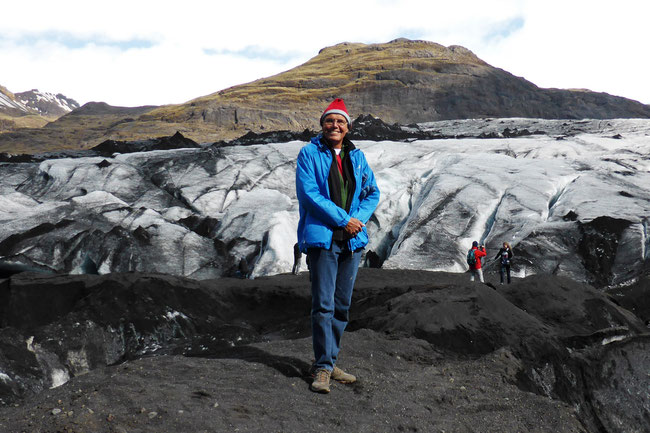
Iceland is cold! No surprises there; the name gives it away. We are visiting Iceland in the spring; however, we have been regularly told that it is a late spring and that it is colder than it should be. Maximum on many days is about 4°C, with blasting wind. Some days the temperature rises to 10 or even 12°C; however, the wind pretty much always blows at 30 to 60 kilometres per hour, which feels like little sharp knives hitting the exposed skin of your face.
In the first few days we did our usual orientation of a 'free' walking tour of the capital Reykjavik in this cold weather, and got pretty cold. However, the sky was clear, and the air dry, and Iceland is beautiful.
Many of Reykjavik’s Streets give you a glimpse of the wind-tossed water of the harbour and frozen snow-speckled mountains – glimpses that remind you that Reykjavik is a cold place.
We did the three-hour walking tour of Reykjavik in 4˚C temperature, with a 50 kilometre-per-hour wind blowing through the town – it was freezing! Here’s the decorative waterfall outside the Reykjavík City Hall:
Frozen!
However, it’s easy to get relief from the cold – anywhere indoors is wonderfully warm, commonly heated by geothermally heated water, or electricity generated geothermally or hydroelectrically.
Keeping warm
So how does a sub-tropical Queenslander survive the Icelandic cold?
The right clothing is, of course, the answer. Unfortunately, the 'official' right clothing, such as a big down-filled jacket, is very expensive, and hard to justify for twelve days in Iceland, when 'home' is subtropical, where these clothes are not likely to be worn again. The right clothing also takes up a lot of room in a bag when it you aren’t using it in a warmer part of the world. The solution is to use layers of clothing, so that each layer is usable in a warmer climate on its own, and combined they work in Iceland, too.
This means that I don't take a big bulky jacket or other specialised cold-climate clothes – the individual 'layers' are items of clothing that you may wear separately for different functions in warmer climates; this increased versatility means you will need less clothing items overall. For example: a light tee-shirt that you might wear at a summer beach resort, or as a pyjama top, is also good for the inner-most layer. Thermal long underwear are compact and light, they work well to convert general-purpose jeans or other long pants into cold-weather clothes, and you can wear them as pyjamas in warmer climates.
So here's what I wear in Iceland and other extremely cold places: lower half: long thermal pants, jeans, thick socks and joggers. (My joggers are well ventilated for warm weather, so they are not ideal; but with US-size-14 feet and travelling light, I can only afford the space in my pack for a limited range of footware!) Upper half: long-sleeved thermal tee shirt (skivvey), shirt (preferably long-sleeved), zip-up cardigan, zip-up light-weight, wind-proof jacket (Katmandu Soft Shell jacket), and a hooded, wind-proof, light-weight rain jacket (Kathmandu Pack-n-Go). On my head I have a woolen beanie, and on my hands I wear ski gloves; the beanie and ski gloves are left over from ski trips in the Australian Alps thirty years ago, but are still going strong. The rain jacket gives extra wind-proofing, but, importantly, its hood seals around my neck and wind-proofs my woollen beanie. Here's what I look like with it all on, at a geyser in Haukadalur Valley:
Even in Iceland you sometimes warm up a bit – you can see that I’ve warmed up a bit here, because I’ve unzipped a couple of layers, and I’ve got my ski gloves off and tucked under my arm:
Even on days when the maximum temperature was 4°C and the wind was blasting and dry I stayed comfortable in these clothes.
Tags
If you enjoyed this blog post, you can find related posts under these headings:
Previous post:
< Previous post
Next post:
future post >
Share this The Journey and the Destination post using your favourite social media:
Would you like to add something, or ask a question? Add a comment below (you can leave the 'Website' field blank):






